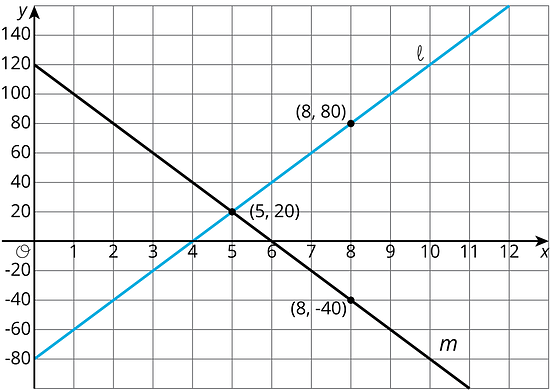Lesson 10Using Linear Relations to Solve Problems
Let’s write equations for real-world situations and think about their solutions.
Learning Targets:
- I can write linear equations to reason about real-world situations.
10.1 Buying Fruit
For each relationship described, write an equation to represent the relationship.
- Grapes cost $2.39 per pound. Bananas cost $0.59 per pound. You have $15 to spend on pounds of grapes and pounds of bananas.
- A savings account has $50 in it at the start of the year and $20 is deposited each week. After weeks, there are dollars in the account.
10.2 Five Savings Accounts
Each line represents one person’s weekly savings account balance from the start of the year.
- Choose one line and write a description of what happens to that person's account over the first 17 weeks of the year. Do not tell your group which line you chose.
- Share your story with your group and see if anyone can guess your line.
- Write an equation for each line on the graph. What do the slope, , and vertical intercept, , in each equation mean in the situation?
- For which equation is a solution? Interpret this solution in terms of your story.
- Predict the balance in each account after 20 weeks.
10.3 Fabulous Fish
The Fabulous Fish Market orders tilapia, which costs $3 per pound, and salmon, which costs $5 per pound. The market budgets $210 to spend on this order each day.
- What are five different combinations of salmon and tilapia that the market can order?
- Define variables and write an equation representing the relationship between the amount of each fish bought and how much the market spends.
- Sketch a graph of the relationship. Label your axes.
- On your graph, plot and label the combinations A—F.
A B C D E F pounds of tilapia 5 19 27 25 65 55 pounds of salmon 36 30.6 25 27 6 4 - Which of these combinations can the market order? Explain or show your reasoning.
- List two ways you can tell if a pair of numbers is a solution to an equation.
Lesson 10 Practice Problems
The owner of a new restaurant is ordering tables and chairs. He wants to have only tables for 2 and tables for 4. The total number of people that can be seated in the restaurant is 120.
- Describe some possible combinations of 2-seat tables and 4-seat tables that will seat 120 customers. Explain how you found them.
- Write an equation to represent the situation. What do the variables represent?
- Create a graph to represent the situation.
- What does the slope tell us about the situation?
- Interpret the and intercepts in the situation.
Triangle is an isosceles triangle with two angles of measure degrees and one angle of measure degrees.
- Find three combinations of and that make this sentence true.
- Write an equation relating and .
- If you were to sketch the graph of this linear equation, what would its slope be? How can you interpret the slope in the context of the triangle?
Select all the equations for which is a solution.
Consider the following graphs of linear equations. Decide which line has a positive slope, and which has a negative slope. Then calculate each line’s exact slope.
